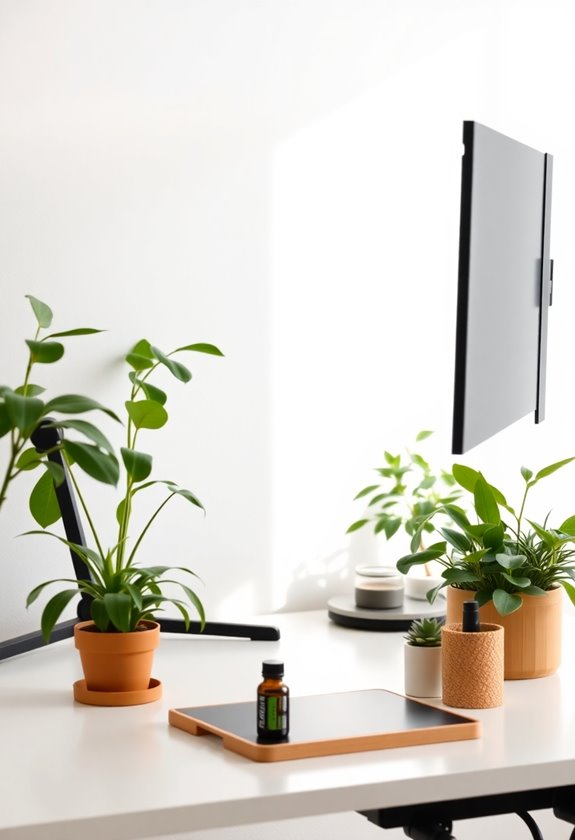You can combat digital fatigue naturally by implementing five key strategies. Start by establishing tech-free zones and notification blocks to set firm digital boundaries. Take regular screen-free breaks using the 20-20-20 rule, which helps reduce eye strain and mental exhaustion. Optimize your workspace with proper lighting and ergonomic positioning to minimize physical stress. Incorporate movement breaks every 30 minutes, focusing on stretches and short walks to boost energy. Finally, protect your eyes by adjusting screen settings and using artificial tears when needed. These foundational steps will guide you toward a more balanced digital lifestyle.
Highlights
- Create tech-free zones in bedrooms and dining areas while implementing strict time blocks for checking notifications.
- Take regular screen breaks using the 20-20-20 rule and engage in outdoor activities or face-to-face conversations.
- Optimize workspace ergonomics with proper lighting, keyboard positioning, and standing desk options to reduce physical strain.
- Incorporate movement breaks every 30 minutes with stretches, short walks, and desk exercises for better blood circulation.
- Adjust screen settings, including brightness and blue light filters, while maintaining proper viewing distance to protect vision.
Set Digital Boundaries

Three key boundaries can help you regain control over your digital life. First, establish dedicated tech-free zones in your home, particularly in your bedroom and dining area, where you'll commit to keeping screens away. Next, you'll need to implement strict time blocks throughout your day when you won't check emails, social media, or respond to non-emergency notifications. Finally, create a digital curfew that starts at least two hours before bedtime, allowing your mind and eyes to decompress from the day's screen exposure.
- Set up device-free spaces in bedroom and dining areas
- Schedule specific times for checking notifications and messages
- Start a digital shutdown routine two hours before sleep
- Turn off non-essential notifications during focused work
- Keep devices out of arm's reach during designated offline periods
Practice Screen-Free Breaks

Taking regular breaks from screens is essential for combating digital fatigue and maintaining your well-being. You'll need to step away from your devices regularly throughout the day to give your eyes and mind the rest they deserve.
Schedule your screen-free breaks using these proven techniques:
- Take a 10-minute break every hour to walk outside or look at distant objects
- Practice the 20-20-20 rule: Every 20 minutes, look at something 20 feet away for 20 seconds
- Set aside dedicated lunch breaks away from all screens
- Create screen-free zones in your home, particularly in your bedroom and dining area
- Engage in outdoor activities, reading physical books, or face-to-face conversations during your breaks
Remember to stretch your muscles and practice deep breathing during these intervals to maximize their restorative benefits.
Optimize Your Workspace

A well-designed workspace can considerably reduce your digital strain throughout the day. Position your screen at arm's length and slightly below eye level to maintain proper posture and reduce neck strain. You'll want to guarantee your chair provides adequate lumbar support while keeping your feet flat on the floor and your knees at a 90-degree angle.
- Adjust room lighting to minimize screen glare and use ambient lighting when possible
- Position your keyboard so your elbows remain at 90 degrees while typing
- Keep essential items within arm's reach to avoid constant stretching
- Add a few plants to your workspace to help reduce eye strain and increase humidity
- Consider using a standing desk converter to alternate between sitting and standing throughout the day
Standing desk converters provide an ergonomic solution to transform your existing desk into an adjustable height workstation.
Move Your Body

Regular movement breaks during screen time serve as one of the most effective ways to combat digital fatigue. You'll want to incorporate these essential movement strategies throughout your workday:
- Stand up and stretch every 30 minutes, focusing on your neck, shoulders, and lower back to release tension from prolonged sitting
- Walk around your space for 2-3 minutes between tasks, which helps reset your mind while increasing blood flow to tired muscles
- Try desk exercises like shoulder rolls, wrist rotations, and ankle circles while you're working to maintain circulation
- Practice the 20-20-20 rule: Every 20 minutes, walk 20 steps and look at something 20 feet away to reduce eye strain and promote movement
These simple movements will help maintain your energy levels and reduce the physical impact of extended screen time.
Using an anti-fatigue mat at your standing desk can provide additional comfort and support while taking movement breaks.
Rest Your Eyes

While physical movement helps combat digital fatigue, your eyes need specific care to prevent strain and maintain ideal function during screen time.
Follow these essential techniques to protect your vision throughout the day:
- Apply the 20-20-20 rule: Every 20 minutes, look at something 20 feet away for 20 seconds
- Position your screen at arm's length and slightly below eye level to reduce neck strain
- Adjust your screen's brightness to match your surroundings, reducing the contrast between your display and ambient light
- Use artificial tears when your eyes feel dry, as screen time can greatly reduce your natural blinking rate
- Enable blue light filters on your devices, especially during evening hours when this type of light can interfere with your natural sleep patterns
Consider wearing blue light glasses to help reduce eye strain and protect your retinas from harmful digital screen emissions.
Frequently Asked Questions
How Does Blue Light Affect Sleep Quality and Circadian Rhythm?
Like a dimmer switch for your brain, blue light disrupts your body's natural sleep patterns by suppressing melatonin production. When you're exposed to blue light from screens, especially in the evening, it tricks your brain into thinking it's still daytime. This interference with your circadian rhythm can lead to difficulty falling asleep, reduced sleep quality, and potential long-term sleep disorders that affect your overall health and well-being.
Can Certain Foods Help Reduce Eye Strain From Digital Devices?
Several nutrient-rich foods can help protect your eyes during screen time and reduce digital eye strain. You'll want to focus on foods high in omega-3 fatty acids like salmon and walnuts, as well as leafy greens packed with lutein and zeaxanthin. Incorporating vitamin A-rich carrots, vitamin C-rich citrus fruits, and zinc-found in eggs and legumes will strengthen your eyes' natural defenses against digital strain and support overall eye health.
What Are the Long-Term Effects of Digital Fatigue on Mental Health?
Prolonged digital fatigue can notably impact your mental well-being, leading to increased anxiety, depression, and disrupted sleep patterns. You'll notice changes in your concentration and memory retention as your brain struggles to process excessive screen time. Extended exposure to digital devices can strain your relationships and work performance, while also triggering chronic stress responses that may result in emotional exhaustion and reduced cognitive function over time.
Are There Specific Apps That Help Track and Manage Digital Wellness?
Just as a compass guides you through unfamiliar terrain, digital wellness apps serve as your personal navigation system through screen time management. You'll find powerful tools like RescueTime and Space that track your device usage patterns and send gentle reminders when you're overextended. Forest app gamifies your digital breaks by growing virtual trees, while Moment and Freedom help you set boundaries and block distracting apps. These apps don't just monitor – they actively guide you toward healthier digital habits.
Which Ergonomic Accessories Are Most Effective for Preventing Digital Fatigue?
You'll want to prioritize these essential ergonomic accessories for preventing digital fatigue:
- An adjustable monitor stand to position your screen at eye level, reducing neck strain
- A quality ergonomic keyboard with wrist support to maintain proper hand positioning
- A vertical mouse that keeps your wrist in a natural handshake position
- An adjustable chair with lumbar support to promote good posture during long work sessions




